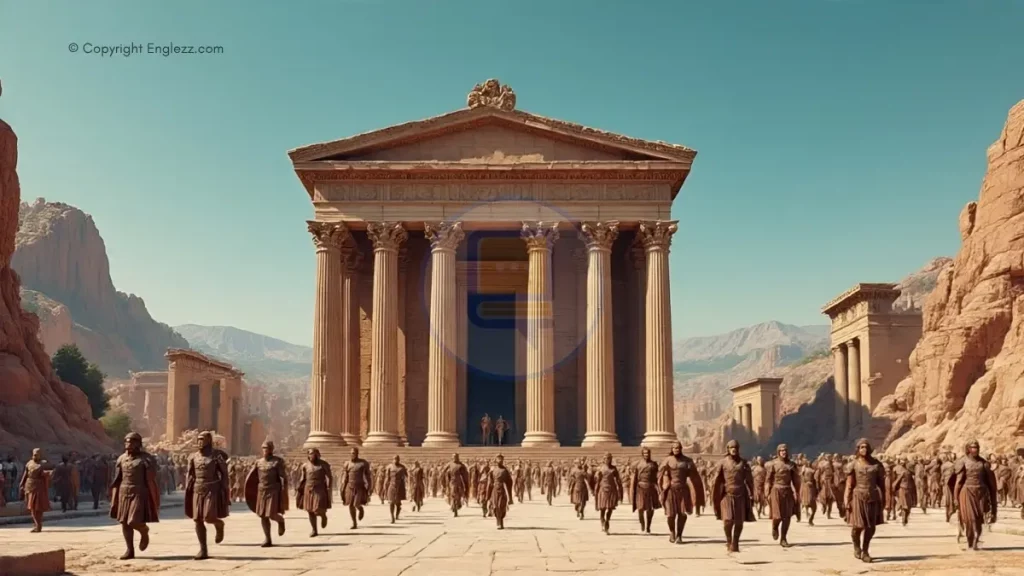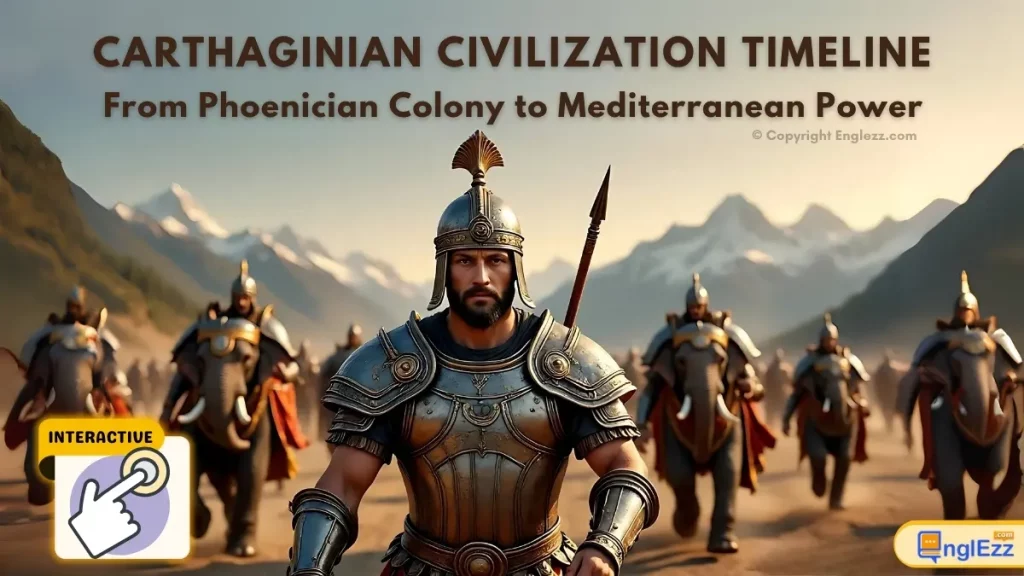
Interactive Carthaginian Empire Timeline
The Journey Of A Phoenician Colony Into A Powerful Empire
Introduction
The Carthaginian Empire Legacy
The Carthaginian Empire was one of the most powerful civilizations of the ancient Mediterranean, dominating trade and politics for centuries before its eventual fall to Rome. Founded by Phoenician colonists from Tyre, Carthage grew from a small settlement to a vast empire controlling trade routes across North Africa, Sicily, Sardinia, and Spain.
Carthage’s history is marked by remarkable achievements in navigation, commerce, and military strategy, particularly under famous leaders like Hannibal Barca. The empire’s conflicts with Rome, known as the Punic Wars, shaped the course of Western history and determined the future of the Mediterranean world.
This timeline explores key events and developments in Carthaginian history, highlighting the empire’s political evolution, military campaigns, cultural achievements, and eventual destruction. From its Phoenician origins to its final days, we trace the rise and fall of this influential civilization.
Foundation & Early Growth
Founded in the 9th century BCE by Phoenician colonists from Tyre, Carthage began as a trading post but quickly grew into an independent power. The city’s strategic location on the North African coast allowed it to dominate Mediterranean trade routes. Early Carthage developed unique political institutions, including the Council of 104 and elected suffetes (judges), while maintaining cultural ties to its Phoenician heritage.
Expansion & Punic Wars
Between the 6th and 3rd centuries BCE, Carthage expanded its influence across the western Mediterranean, establishing colonies and controlling trade. This brought it into conflict with Greek city-states and eventually Rome. The three Punic Wars (264-146 BCE) against Rome marked the height of Carthaginian military power under Hannibal, but ultimately led to the empire’s destruction.
Cultural Legacy
Though Carthage was destroyed in 146 BCE, its influence persisted. Carthaginian innovations in shipbuilding, navigation, and agriculture influenced Roman practices. The empire’s commercial networks laid foundations for Mediterranean trade routes that would flourish under Rome. Carthaginian religious practices, particularly the worship of Baal Hammon and Tanit, left archaeological traces across North Africa and influenced later cultures.
Explore the interactive timeline below to discover key events that shaped the Carthaginian Empire. Click on any event to learn more, and test your knowledge with our quiz when you’re ready!
Timeline
Founding of Carthage
According to legend, Queen Dido (Elissa) flees Tyre and establishes Carthage as a Phoenician colony in North Africa.
Read moreThe traditional date for the founding of Carthage is 814 BCE, though archaeological evidence suggests the city may have been established slightly later, around 760 BCE. According to legend, Carthage was founded by Queen Dido (Elissa), a Phoenician princess who fled her home city of Tyre after her brother Pygmalion murdered her husband.
The story tells how Dido negotiated with local Berber chieftains to purchase land, famously asking for only as much as could be covered by an oxhide. She then cut the hide into thin strips and encircled a large hill, which became the Byrsa (citadel) of Carthage. This clever negotiation became symbolic of Carthaginian commercial acumen.
Carthage’s location on a peninsula in the Gulf of Tunis provided excellent natural harbors and defensible position. The city quickly grew into an important trading hub, connecting Phoenician colonies in the western Mediterranean with the Levant. Its early economy relied on trade in purple dye, textiles, precious metals, and other luxury goods.
While maintaining cultural and religious ties to Phoenicia, Carthage developed its own distinct identity and political institutions, gradually becoming independent of Tyre’s influence. The city’s early growth laid the foundation for what would become a vast commercial empire.
Further Reading
- Miles, Richard. Carthage Must Be Destroyed: The Rise and Fall of an Ancient Civilization (2010)
- Lancel, Serge. Carthage: A History (1995)
Emergence as Independent Power
Carthage becomes fully independent from Tyre and begins establishing its own colonies and trade networks.
Read moreBy the mid-7th century BCE, Carthage had grown powerful enough to assert its independence from its mother city of Tyre. This transition occurred as Assyrian pressure weakened Phoenician city-states in the Levant, reducing their ability to maintain overseas colonies.
As an independent city-state, Carthage began establishing its own colonies along the North African coast, in Sicily, Sardinia, the Balearic Islands, and southern Spain. These colonies served both as trading posts and agricultural centers, securing resources for the growing city.
Carthage also developed its unique political system during this period. The government was oligarchic, with power shared among wealthy merchant families. Two annually elected suffetes (judges) served as chief magistrates, while a Council of Elders and a more democratic Assembly of Citizens played advisory and legislative roles. A unique Council of 104 served as a high court and supervised military commanders.
The city’s economy diversified beyond trade to include significant agricultural production in its hinterland. Carthaginian farmers developed advanced irrigation techniques and cultivated olives, grapes, and grain, which became important exports alongside traditional Phoenician manufactured goods.
Further Reading
- Hoyos, Dexter. The Carthaginians (2010)
- Warmington, B.H. Carthage (1960)
Battle of Alalia
Carthage allies with Etruscans to defeat Greek forces near Corsica, securing control of western Mediterranean trade routes.
Read moreThe Battle of Alalia (circa 535 BCE) marked a pivotal moment in Carthage’s struggle with Greek colonists for control of the western Mediterranean. The conflict arose when Phocaean Greeks from Asia Minor established a colony at Alalia (modern Aléria) on Corsica, threatening Carthaginian and Etruscan trade interests in the region.
Carthage formed an alliance with the Etruscan city-states and confronted the Greek fleet near Alalia. According to Herodotus, the Greeks won a “Cadmean victory” – they drove the Carthaginian-Etruscan fleet from the field but suffered such heavy losses that they were forced to abandon Corsica. The Phocaeans relocated to Elea in southern Italy.
This victory secured Carthaginian dominance in Sardinia and the western Mediterranean while checking Greek expansion. It also strengthened Carthage’s alliance with the Etruscans, which would last for centuries. The battle demonstrated Carthage’s growing naval power and willingness to defend its commercial interests militarily.
Following Alalia, Carthage consolidated its control over Sardinia, establishing permanent settlements and exploiting the island’s agricultural and mineral resources. This period also saw increasing Carthaginian involvement in Sicily, setting the stage for later conflicts with Greek city-states on the island.
Further Reading
- Goldsworthy, Adrian. The Fall of Carthage: The Punic Wars 265-146 BC (2006)
- Freeman, Edward A. History of Sicily (1891)
Battle of Himera
Carthage suffers a major defeat against Greek forces in Sicily, temporarily halting its expansion on the island.
Read moreIn 480 BCE, the same year as the famous Battle of Salamis between Greeks and Persians, Carthage launched a major expedition against Greek colonies in Sicily. The Carthaginian force, led by General Hamilcar, landed at Panormus (modern Palermo) with a large army reportedly numbering 300,000 men (though ancient sources likely exaggerated this figure).
The immediate cause was a request for assistance from Terillus, tyrant of Himera, who had been expelled by Theron of Akragas. Carthage saw an opportunity to check the growing power of Greek city-states in Sicily, particularly Syracuse and Akragas.
The Carthaginians besieged Himera but were defeated by a combined force led by Gelon of Syracuse and Theron of Akragas. According to tradition, Hamilcar died during the battle, possibly by suicide when defeat became inevitable. The Greeks claimed to have destroyed the Carthaginian fleet and captured many prisoners.
This defeat forced Carthage to pay a substantial indemnity and temporarily withdraw from Sicilian affairs. It marked the beginning of a pattern of Carthaginian-Greek conflict in Sicily that would continue intermittently for centuries. The battle also demonstrated that despite its naval power, Carthage struggled to project military force successfully against determined Greek resistance.
Further Reading
- Freeman, Edward A. History of Sicily (1891)
- Diodorus Siculus. Library of History, Book XI
Carthaginian Campaigns in Sicily
Hannibal Mago launches successful campaigns against Greek cities in Sicily, reasserting Carthaginian influence.
Read moreIn 409 BCE, Carthage under Hannibal Mago (grandson of Hamilcar who died at Himera) launched a major campaign to reassert control over western Sicily. The expedition was prompted by appeals from Segesta, a non-Greek city in conflict with Selinus (Selinus supported Segesta’s rival, Syracuse).
Hannibal’s forces first attacked Selinus, which fell after a brief siege. The city was brutally sacked, with thousands killed or enslaved. This demonstrated Carthage’s willingness to use extreme violence against Greek cities that resisted its authority.
The Carthaginians then marched on Himera, site of their earlier defeat. After capturing the city, Hannibal reportedly executed 3,000 prisoners as retribution for the Carthaginians killed in 480 BCE. He then destroyed the city completely, though a new settlement would later be established nearby.
These victories reestablished Carthage as the dominant power in western Sicily and demonstrated its military capabilities when properly led. However, they also intensified Greek hostility toward Carthage, setting the stage for future conflicts with Syracuse and other Greek city-states.
Further Reading
- Diodorus Siculus. Library of History, Book XIII
- Hoyos, Dexter. Mastering the West: Rome and Carthage at War (2015)
First Punic War
Carthage and Rome fight for control of Sicily in a 23-year conflict that ends with Carthage’s defeat and loss of Sicily.
Read moreThe First Punic War (264-241 BCE) marked the beginning of Carthage’s fatal struggle with Rome. The conflict originated in a dispute over Messana (modern Messina) in Sicily, where a group of Italian mercenaries called the Mamertines appealed to both Rome and Carthage for protection against Syracuse.
Carthage initially established a garrison in Messana, but the Mamertines eventually turned to Rome. The Roman decision to intervene in Sicily, breaking with their traditional policy of avoiding overseas commitments, brought them into direct conflict with Carthaginian interests.
The war featured several notable Carthaginian commanders, particularly Hamilcar Barca (father of Hannibal), who conducted skillful guerrilla operations in Sicily’s mountainous interior. However, Rome’s ability to build a powerful navy and adapt to naval warfare proved decisive. After major naval victories at Mylae (260 BCE) and the Aegates Islands (241 BCE), Rome forced Carthage to sue for peace.
The Treaty of Lutatius required Carthage to evacuate Sicily, pay a large indemnity, and refrain from attacking Syracuse or its allies. This marked Rome’s first overseas province and Carthage’s first major territorial loss. The financial strain of the war and subsequent Mercenary War (240-238 BCE) weakened Carthage but also set the stage for its expansion in Spain under the Barcid family.
Further Reading
- Goldsworthy, Adrian. The Fall of Carthage: The Punic Wars 265-146 BC (2006)
- Polybius. The Histories, Book I
Second Punic War
Hannibal Barca leads Carthage in its most famous conflict with Rome, achieving stunning victories but ultimately failing to defeat Rome.
Read moreThe Second Punic War (218-201 BCE) was Carthage’s most famous conflict with Rome, marked by Hannibal Barca’s extraordinary military campaigns. The war began when Hannibal attacked the Roman-allied city of Saguntum in Spain, provoking Roman intervention. Hannibal then executed one of history’s most daring military maneuvers by leading his army, including war elephants, across the Alps into Italy.
Hannibal achieved spectacular victories at Trebia (218 BCE), Lake Trasimene (217 BCE), and Cannae (216 BCE), where he destroyed a Roman army twice the size of his own. These victories demonstrated Hannibal’s tactical genius and nearly broke Roman resistance. However, Hannibal lacked the siege equipment and reinforcements needed to take Rome itself.
Rome adopted a strategy of avoiding direct confrontation with Hannibal while attacking Carthaginian holdings elsewhere. Scipio Africanus conquered Carthaginian Spain and then invaded North Africa, forcing Hannibal’s recall from Italy. The decisive Battle of Zama (202 BCE) saw Scipio defeat Hannibal, ending the war.
The peace terms were harsh: Carthage lost its overseas territories, its navy was limited to 10 ships, and it was forbidden to wage war without Roman permission. Despite these restrictions, Carthage recovered economically, leading to Roman fears and ultimately the Third Punic War.
Further Reading
- Livy. The War with Hannibal
- Daly, Gregory. Cannae: The Experience of Battle in the Second Punic War (2002)
Third Punic War
Rome besieges and destroys Carthage, ending the Carthaginian Empire and scattering its population.
Read moreThe Third Punic War (149-146 BCE) resulted in the complete destruction of Carthage. Despite complying with Roman demands after the Second Punic War, Carthage’s economic recovery alarmed Rome, particularly the conservative senator Cato the Elder, who famously ended all his speeches with “Carthage must be destroyed” (Carthago delenda est).
Rome used a technical violation of the peace treaty (Carthage defending itself against Numidian encroachment without Roman permission) as pretext for war. When Rome demanded that Carthage abandon its city and move inland, the Carthaginians refused and prepared for siege.
The siege of Carthage lasted three years, with the Carthaginians demonstrating remarkable resilience under Hasdrubal the Boetharch. They rebuilt their navy, manufactured weapons daily, and withstood Roman assaults. However, in 146 BCE, Scipio Aemilianus (adopted grandson of Scipio Africanus) breached the city walls.
The Romans systematically destroyed Carthage, killing or enslaving its population. According to tradition, the city was plowed with salt, though this may be later invention. Carthaginian territory became the Roman province of Africa, marking the definitive end of Carthaginian political independence.
Further Reading
- Appian. The Punic Wars
- Miles, Richard. Carthage Must Be Destroyed: The Rise and Fall of an Ancient Civilization (2010)
Tophets and Child Sacrifice
Carthage’s controversial religious practices, including possible child sacrifice, are evidenced by tophet burial sites.
Read moreCarthaginian religion included the controversial practice of child sacrifice, evidenced by tophet burial sites found in Carthage and other Punic settlements. These sacred precincts contained urns with cremated remains of infants and young animals, accompanied by dedicatory stelae to the gods Baal Hammon and Tanit.
Ancient Greek and Roman sources describe Carthaginian child sacrifice in graphic terms, though modern scholars debate the extent and nature of the practice. Some argue that these were sacrifices during times of crisis, while others suggest they were burials for children who died naturally, sanctified through special rituals.
The tophet at Carthage, discovered in 1921, contains over 20,000 urns deposited between 400-200 BCE. Inscriptions on accompanying stelae use the term “mlk” (often interpreted as a sacrificial term) and frequently mention vows fulfilled to the gods. Archaeological evidence shows the remains are mostly of infants, with some older children and animals.
This practice, whether actual sacrifice or symbolic offering, demonstrates the Carthaginians’ devotion to their gods and willingness to make extreme commitments. It also became a powerful element in anti-Carthaginian propaganda used by their Greek and Roman enemies.
Further Reading
- Stager, Lawrence E. and Samuel R. Wolff. “Child Sacrifice at Carthage.” Biblical Archaeology Review (1984)
- Quinn, Josephine Crawley. “The Cultures of the Tophet.” Hermathena (2011)
Mago’s Agricultural Manual
Carthaginian writer Mago compiles a comprehensive agricultural treatise that influences Roman farming practices.
Read moreMago the Carthaginian (not to be confused with military commanders of the same name) wrote a 28-volume agricultural manual in Punic that became highly influential in the ancient world. After Carthage’s destruction, the Roman Senate ordered the work translated into Latin (with Greek and Latin versions also circulating).
Mago’s work covered all aspects of North African agriculture, including cultivation of vines, olives, and fruit trees; animal husbandry; beekeeping; and farm management. He emphasized practical knowledge gained from experience rather than theoretical approaches. Some surviving fragments advise on selecting land, managing slave labor, and treating sick animals.
Roman writers like Columella frequently cited Mago, and his influence can be seen in later Roman agricultural practices. The work was particularly valued for its insights into cultivating crops in North African conditions, which Romans later applied to their African provinces.
Mago’s manual demonstrates Carthage’s sophisticated agricultural knowledge and its importance to the Carthaginian economy. While Carthage is often remembered for its maritime trade, agriculture was equally vital, particularly in its later centuries when territorial losses reduced commercial opportunities.
Further Reading
- Columella. De Re Rustica (references Mago’s work)
- Varro. Rerum Rusticarum (references Mago’s work)
Roman Rebuilding of Carthage
Julius Caesar later establishes a Roman colony on the site, recognizing its strategic and economic importance.
Read moreDespite Rome’s symbolic destruction of Carthage in 146 BCE, the site’s strategic and economic importance led to its eventual reoccupation. The Gracchi brothers proposed reestablishing Carthage as a Roman colony in 122 BCE, though this plan was abandoned after political opposition.
Julius Caesar later revived the idea, and after his death, Augustus established Colonia Julia Carthago in 29 BCE. The new city flourished as capital of the Roman province of Africa, becoming one of the empire’s largest and most prosperous cities.
Roman Carthage retained some Punic cultural elements while thoroughly adopting Roman architecture and institutions. The city became an important center of early Christianity, producing notable figures like Tertullian and hosting church councils.
The Roman revival of Carthage demonstrates how the location’s advantages overcame ideological opposition. It also symbolizes the complex relationship between Rome and Carthage – bitter enemies whose fates became inextricably linked through conflict and eventual absorption.
Further Reading
- Raven, Susan. Rome in Africa (1993)
- Ennabli, Abdelmajid. Carthage: A UNESCO World Heritage Site (2018)
Archaeological Rediscovery
Excavations at Carthage reveal the scale and sophistication of Punic civilization to modern scholars.
Read moreModern understanding of Carthage began with archaeological excavations in the 19th century, particularly after Tunisia became a French protectorate in 1881. Early digs focused on Roman remains, but attention gradually turned to Punic layers beneath.
Key discoveries include:
- The tophet (1921), providing evidence about Carthaginian religion
- The harbors (Punic and Roman), showing Carthage’s maritime importance
- Residential quarters revealing urban layout and architecture
- Necropolises with artifacts demonstrating trade connections
These excavations have challenged the negative portrayal of Carthage in Greco-Roman sources, revealing a sophisticated urban civilization with advanced engineering, artistic traditions, and far-reaching commercial networks. The UNESCO World Heritage designation in 1979 recognized Carthage’s importance to human history.
Modern Tunisians view Carthage as part of their national heritage, though interpretations of its relationship to contemporary identity vary. The site remains an active area of archaeological research, with new discoveries continuing to reshape our understanding of this influential ancient civilization.
Further Reading
- Lancel, Serge. Carthage: A History (1995)
- Hurst, Henry. Excavations at Carthage: The British Mission (2010)
Quiz
Test Your Knowledge of Carthaginian History
Frequently Asked Questions
Common Questions About Carthage
The Carthaginians spoke Punic, a variety of Phoenician. Punic was a Semitic language closely related to Hebrew and other Canaanite languages. After Carthage’s fall, Punic continued to be spoken in North Africa for centuries, influencing the local Berber languages and leaving some traces in Maghrebi Arabic.
Key facts about the Punic language:
- Used a Phoenician-derived alphabet
- Had many loanwords in Berber languages
- Survived in some areas until Augustine’s time (4th-5th century CE)
- Most inscriptions are religious or funerary
Carthage had a complex republican government that combined oligarchic, aristocratic, and democratic elements:
- Suffetes: Two annually elected chief magistrates (similar to Roman consuls)
- Council of Elders: A senate-like body of wealthy citizens
- Assembly of Citizens: Could vote on important matters and elect officials
- Council of 104: A judicial body that oversaw generals and officials
This system proved stable for centuries but struggled during military crises when strong leaders like the Barcids gained unusual power. Aristotle praised Carthage’s constitution as combining elements of monarchy, aristocracy, and democracy.
The question of Carthaginian child sacrifice remains controversial among historians:
- Archaeological evidence: Tophets contain urns with cremated infant remains, often with dedicatory inscriptions to Baal Hammon and Tanit
- Literary accounts: Greek and Roman sources describe graphic child sacrifice rituals
- Modern interpretations:
- Traditional view: Carthaginians sacrificed children during crises
- Revisionist view: Tophets were special cemeteries for children who died naturally
- Middle view: Some sacrifices occurred alongside regular infant burials
While the exact nature of the practice is debated, the tophet phenomenon clearly reflects Carthage’s distinctive religious traditions.
Carthage’s defeat in the Punic Wars resulted from several factors:
- Roman resilience: Rome could absorb massive losses and keep fighting
- Naval inferiority: After the First Punic War, Carthage never matched Rome at sea
- Limited manpower: Carthage relied more on mercenaries than citizen soldiers
- Strategic errors: Hannibal failed to attack Rome after Cannae
- Political divisions: Carthaginian oligarchy sometimes withheld support from generals
- Roman adaptability: Rome learned from defeats and improved its military
Ultimately, Rome’s greater resources, manpower reserves, and political unity proved decisive in the long conflict.
Conclusion
The Legacy of Carthage
The Carthaginian Empire represents one of history’s great “what if” scenarios – a civilization that might have dominated the Mediterranean world had it prevailed against Rome. For centuries, Carthage stood as Phoenicia’s most successful daughter, building a commercial empire that stretched across North Africa and the western Mediterranean.
Carthage’s history demonstrates both the potential and limitations of a maritime trading empire. Its commercial networks and naval power allowed it to prosper for centuries, but ultimately proved insufficient against Rome’s territorial base and relentless militarism. The Punic Wars marked a pivotal moment in Western history, determining whether a mercantile or agrarian-military model would dominate the Mediterranean world.
Key Takeaways
Phoenician Origins
Carthage began as a Phoenician colony but developed its own distinct identity and political institutions.
Commercial Empire
Carthage built a vast network of trade routes and colonies across the western Mediterranean.
Military Innovation
Carthage produced brilliant generals like Hannibal who revolutionized warfare.
Conflict with Rome
The Punic Wars determined the Mediterranean’s future and ended Carthaginian independence.
Cultural Achievements
Carthage developed sophisticated agriculture, urban planning, and maritime technology.
Enduring Influence
Despite its destruction, Carthage’s legacy influenced Roman Africa and Mediterranean history.
Today, Carthage reminds us that history is written by the victors. The Carthaginians’ own records were destroyed, leaving their story to be told largely by Greek and Roman enemies. Modern archaeology continues to reveal new aspects of their civilization, challenging ancient stereotypes and recovering the richness of Punic culture. As we reassess Carthage’s place in history, we gain a more nuanced understanding of the ancient Mediterranean world and the complex civilization that nearly shaped its destiny.
Recommended Reading
- Miles, Richard. Carthage Must Be Destroyed: The Rise and Fall of an Ancient Civilization (2010)
- Hoyos, Dexter. The Carthaginians (2010)
- Lancel, Serge. Carthage: A History (1995)
- Goldsworthy, Adrian. The Fall of Carthage: The Punic Wars 265-146 BC (2006)
- Warmington, B.H. Carthage (1960)










Carthaginian Empire: Explore the rise from a humble Phoenician colony to a dominant Mediterranean power that influenced ancient civilizations.